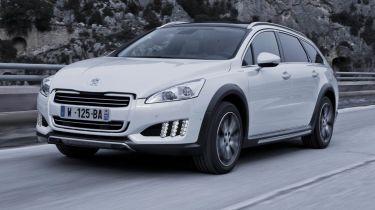Peugeot 508 RXH
Peugeot 508 4x4 estate flagship gets high-riding suspension and hybrid diesel powertrain from the 3008

On paper, the hybrid RXH is in a different league for efficiency, which make this car a fleet buyer’s dream. Compared to an Audi A4 Allroad TDI 170, the RXH will cost you £125 a month less BIK – which is why 90 per cent of sales will be to business users. It’s just a shame that the handsome styling, luxurious cabin and fuel economy are let down by the crude gearbox. Look past that though, and the RXH is an impressive showcase of what Peugeot is capable of.
Peugeots don’t get any more premium than this. The 508 RXH is a high-riding 4x4 version of the 508 SW estate with a diesel engine to turn the front wheels and an electric motor at the back - and Peugeot has pulled out all the stops to make this the pinnacle of the range.
There’s no missing it on the road - the track has been widened by 40mm, the ride height has been raised by 50mm and grey cladding has been added around the bottom of the bodywork - a tried and tested way to toughen up the looks. Also unique to the RXH are the three-strip LED daytime running lights, supposedly inspired by a lion’s claw.
Only one trim is available, but it includes every option you can imagine. Sat-nav, a full-length panoramic roof and leather seats come as standard – the result is a cabin that isn’t quite a match for an Audi, but feels plush for a Peugeot. The only drawback is the boot floor, which has been raised slightly to accommodate the electrics – even so, there’s still a 423-litre boot, or 1,439 litres with the rear seats folded down.
The rev counter has been replaced with a dial displaying the current power output of the electric motor, or if the battery is being charged by either the regenerative braking or directly from the engine. A power-flow diagram on the central screen, much like the one in the Toyota Prius, shows you precisely how the wheels are being driven at any one time.
This is the kind of car you need a tutorial on before driving it, so it’s worth recapping exactly how the HYbrid4 system works. Fitting the 37bhp electric motor brings a number of benefits – firstly in zero-emissions mode it can take over completely from the engine for up to two miles. It also adds a boost effect when you plant your right foot and helps ‘fill-in’ the gap in torque when the automated manual gearbox changes gear.
How the engine and electric motor interact depends on which one of four driving modes you select. In Sport mode, they work together to maximum capacity, unleashing the car’s full 200bhp potential. 4WD mode splits the torque 60:40 front-rear, while Auto mode leaves decisions to the computer to maximise efficiency, allowing electric-only running when you're crawling around town, and the diesel engine to take over completely at higher speeds. ZEV mode restricts the car to its zero-emission mode until the battery runs too low.
With the engine off and the batteries doing the work, refinement is superb - even when the diesel kicks in it does so discreetly. But in Auto and 4WD modes acceleration is lacking and accompanied by a crude roar from the engine under heavy throttle. What really spoils the driving experience is the slow-witted automated manual gearbox, which physically jerks you forward in your seat during upshifts. Choose manual mode and lift off the throttle as you pull the right paddle, and you can make smoother progress – but in this day and age when other automated manuals can shift smoothly without lifting off, it’s a tough compromise to swallow.
Slot it into Sport mode, and things improve. The shift time is cut and the boost effect of the electric motor improves throttle response. Fling it around and you’ll notice more body roll than a standard diesel 508 – a product of the RXH’s extra 110kg and taller ride height – but driving like a hooligan isn’t what this car is about. Do so and those claimed economy figures will be impossible to achieve.







